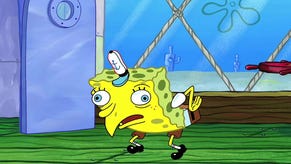How to play Magic: The Gathering Arena: A beginner's guide
Get started with MTG Arena, from navigating menus to expanding your card collection.
Whether you’re enjoying playing Magic: The Gathering in person or looking to start a new hobby for times when you’re stuck indoors, Magic: The Gathering Arena could be the perfect antidote. It can get a little daunting at times though, even if you’re a seasoned MTG veteran.
Is Arena any different to the tabletop version? Where are you supposed to even begin? How on earth are you supposed to navigate these menus? Lucky for you, we’ve put together this beginner’s guide for everything you need to know when booting up Magic: The Gathering Arena.
How to play MTG Arena
- Differences between MTG and MTG Arena: How MTG Arena compares to its tabletop counterpart.
- How to get started in Magic: The Gathering Arena: From learning the ropes to putting together your first deck, here's where to begin.
- How to navigate the MTG Arena interface: Lost in menus? Let us help you find what you're looking for.
- How to get more cards in MTG Arena Expand your collection by buying or earning extra cards.
- How to get gems: How to earn more of MTG Arena's digital currency.
Differences between MTG and MTG Arena
Players of tabletop Magic: The Gathering will find it easy to get used to Arena. You have the same cards, rules and mechanics you’re used to from previous games of MTG. There are a few things you should keep in mind though.
Tabletop Magic: The Gathering tournaments use a best-of-three system, in which players can use cards from a sideboard to adjust their deck between matches. Whilst this is a way to play Arena, the default is best-of-one. This means it’ll often be a lot simpler than your standard tabletop matchup, and easier for beginners to get to grips with.
Magic: The Gathering Arena has in place a special system for opening hands. The app generates two separate hands and gives you the one with the statistically healthier mix of land and spell cards. This means Arena is typically easier to get to grips with, as you’re less likely to be messed around early on by random chance.
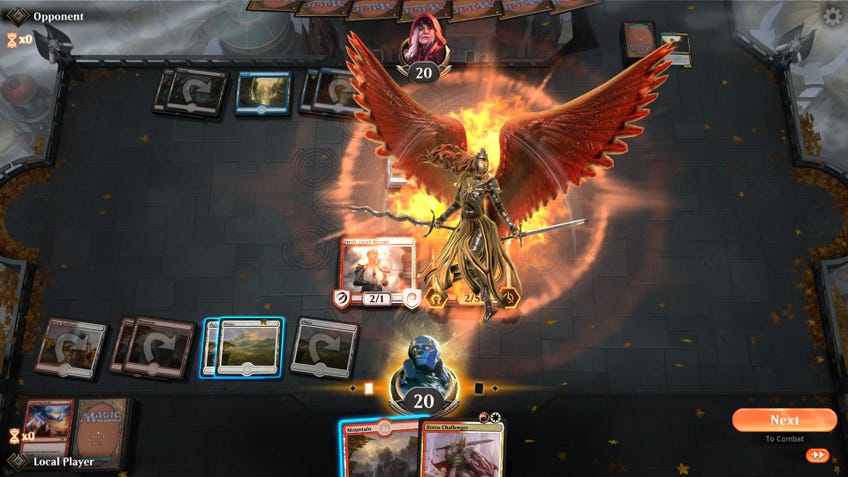
You also have more chances to get a bigger collection in Arena, as our later section delves deeper into. There is no secondary market for Arena, but overall it should be cheaper since you can’t pay huge amounts of money for the most powerful cards second-hand.
The Magic: The Gathering sets available on Arena only include ones from its release onward, so you can’t play super old decks from a decade ago. If this is your style, stick to your big old-school collections.
How to get started in Magic: The Gathering Arena
Upon logging in to Magic: The Gathering Arena, you’ll be placed in a few tutorials that’ll explain the basic mechanics of the game. Lands, creatures, phases, spells: it’s all there. Obviously, seasoned veterans need not worry and can blaze through these, but for new players these tutorials do a great job of explaining how to play MTG.
As well as the initial tutorials, there are more lessons available - one for each of the mana colours - known as ‘Color Challenges’. Access these by clicking on the circle of all the mana colour icons at the bottom of the Home menu. These are well worth trying out, as you get a copy of the deck you use after each battle. They aren’t the best decks in the world, but you’ll be used to how the cards work and your specific win conditions, so they’re solid starting points.
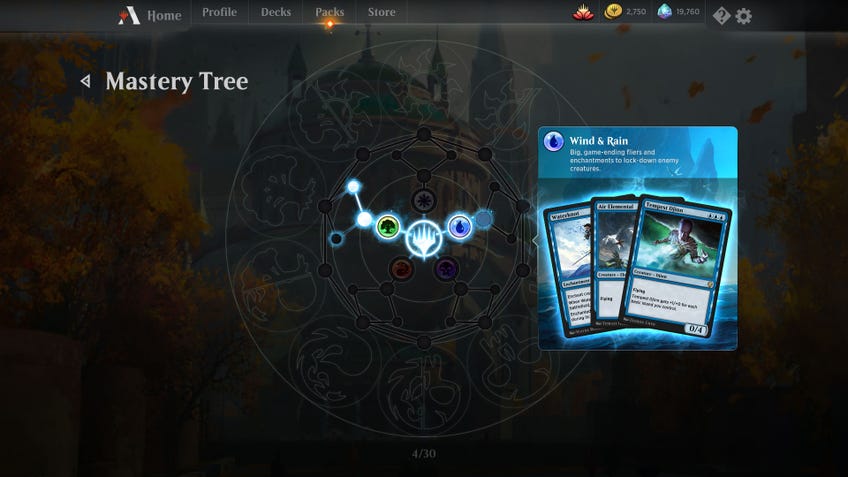
Head online and play a few matches with these decks, too. You’ll earn cards and packs as you go, so every game helps your progression. Losing matches is a vital part of learning the game, so get beat down a few times and have a think about what went wrong. Switch out one card at a time, consider how you could have avoided the outcome and keep that at the front of your mind in the next game. The more you lose, the more situations you’ll become aware of.
One tip we’d highly recommend at the start of your Magic: The Gathering Arena journey is don’t netdeck right away. Netdecking is when you go online and find the best meta decks all the top players on the ladder are using. You have a small collection at the moment, and wasting all your wildcards on a deck archetype you might not like is a one-way street to you being grumpy later on about your lack of available cards.
Of course, it’s possible to purchase goodies within Magic: The Gathering Arena. If you are up for putting real money into Arena, a decent first step is the Welcome Bundle. Available at the Store menu, it costs €4.99 and nets you 2,500 Gems and five Core Set packs.

How to navigate the MTG Arena interface
Magic: The Gathering Arena can look pretty daunting when you first open it up. All these panels, so much stuff to do. However, it’s nice and simple once you know what you’re looking for specifically.
Where to buy packs in MTG Arena
Click the ‘Store’ panel at the top of the menu bar. From here, you’ll see another mountain of information. Click what you want to buy at the bottom of the screen, and then choose your specific purchase. Gems are only purchasable with real money - you can’t directly turn coins into gems aside from special offers.
Other goodies can be bought by different methods. The ‘Bundles’ section often has special deals on cards and cosmetics, whilst ‘Packs’ are pretty standard price-wise.
Choose the specific set you want your packs to come from by clicking the set icon above the purchase carousel, keeping in mind which sets are rotating out of Standard on September 17th 2020. Be wary when purchasing the following, as they are leaving the format soon:
- Guilds of Ravnica
- Ravnica Allegiance
- War of the Spark
- Core Set 2020

How to build a deck
To build a deck in Magic: The Gathering Arena, head to the ‘Decks’ tab in the main menu. From here, you can click the ‘+’ icon to make a brand new deck.
Click the mana colours you want to build your deck around and start adding your cards - a nice tip here is using the mountain icon second from the right to filter out everything but Lands. You can even click ‘Suggest Lands’ and the game’s AI will chuck in the number and colours they think you’ll need based on your current deck. The ‘Craft’ icon in the top-right allows you to use your Wildcards to make new cards, up to a maximum of four copies of each. The little notches above the card’s picture indicate the number of copies you own, and the number filled in show how many are in your current deck.
Playing a game of Magic: The Gathering Arena
How do you actually play a game of MTG? There are so many options, it’s tough to figure out where to go. Well, keep in mind the little toggle in the top-right labelled ‘Arena Play Modes’. Tapping on it lets you toggle advanced play modes on and off, giving players more options based on their experience level.
New players might want to stick to the basic play modes to start with. Advanced modes let you play things like best-of-three, so tabletop MTG players might fancy this option.
The basic MTG Arena play modes are:
- Bot Match
- Play
- Brawl
- Standard Ranked
- Historic Ranked
Bot Match is perfect for new players. It lets you practise against Magic: The Gathering Arena’s AI without having to worry about real-life players destroying you with fancy decks.
Play allows you to find a quick unranked best-of-one match, whilst Brawl requires you to build a deck around a legendary creature or planeswalker. You’ll need to actually have these cards available if you plan on playing this mode, and some decks will be ineligible.
Standard Ranked puts you on the competitive ladder, using only the cards available in the Standard format at the moment, but if you have more cards from previous sets, choose Historic Ranked to have the freedom to use all the cards you want.
The Events tab is where you’ll find Draft game modes. There are three types of draft: Quick, Premier and Traditional.
- Quick: Draft against an AI with no time constraints or waiting. You get up to three losses to achieve seven wins.
- Premier: Draft against other players in a best-of-one format. You get three losses to win seven times.
- Traditional: A best-of-three draft against other players, with a total of three matches.
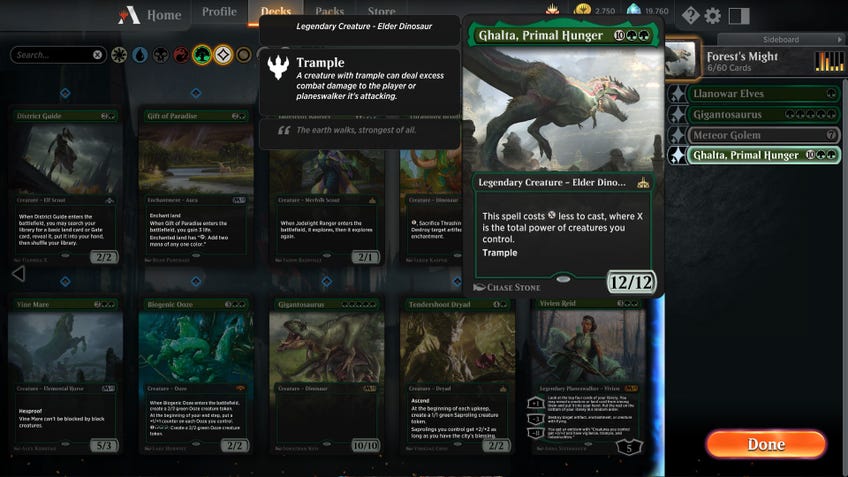
How to get gems
Gems are a currency purchasable with real-life money. There are a couple different ways to obtain them, and they can be spent on on a number of things within MTG Arena, including booster packs and cosmetics in the Store. Here’s how to get them:
Purchase Gems
Gems translate into money by the following amounts:
- 750 gems: $4.99
- 1,600 gems: $9.99
- 3,400 gems: $19.99
- 9,200 gems: $49.99
- 20,000 gems: $99.99
These prices remain consistent if your prices are in Euros too. Head into the Store and click the ‘Gems’ tab at the bottom of the screen to buy.
Events
You can earn Gems by playing Gem-reward events too. Click ‘Play’ and you’ll be able to join events by paying Coins or Gems. If you play well, or just enter with Coins, you’ll be able to make a profit. For example, Quick Draft Core Set 2021 allows entry for 750 Gems or 5000 Coins, and if you achieve six wins you’ll earn 850 Gems and a Core Set 2021 pack. Remember to make sure the event rewards are Gems too - before purchasing entry you can review the potential prizes across the bottom of the screen.

How to get more cards in MTG Arena
Progression is pretty steady in Magic: The Gathering Arena, so you’ll be able to play with a solid variety of decks and playstyles early on in your journey. However, there are a few ways to get more cards and increase your collection.
Set Mastery
Set Mastery acts somewhat like a Battle Pass in other free-to-play games. You can purchase the ‘Mastery Pass’, which acts like a premium tier, for 3,400 Gems. This comes to $19.99, which if you’re playing every day is worth the investment. You get gems, packs, cards and cosmetics from the Mastery Pass, so for building up your collection as you play, you might want to give it a go.
Gems are used to buy entry to special game modes, cosmetics, and card packs.
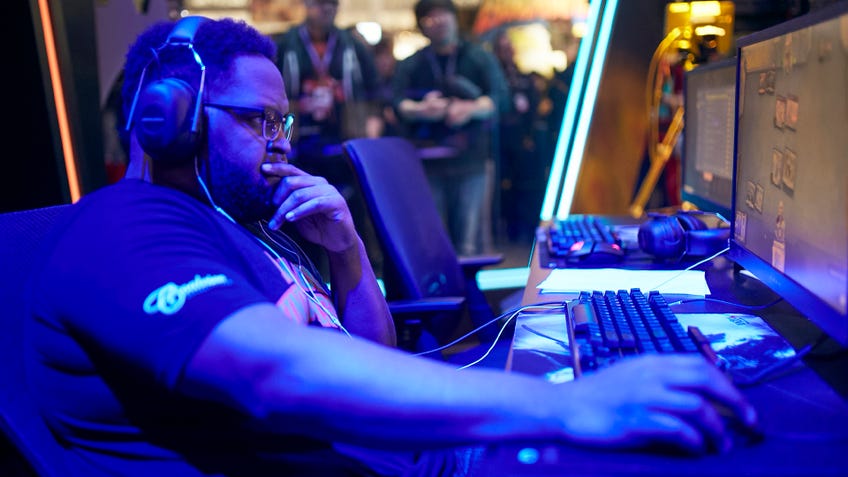
Buy card packs
Each card pack costs 1,000 Coins or 200 Gems, and can be bought in bulk with Gems. Opening packs also gives you Wildcards, which can be traded in for any card of the corresponding rarity. Be careful though - you can’t turn a card back into a Wildcard, so choose wisely.
If you purchase physical Magic decks, you’ll be able to register them in Arena as codes. To do this, look inside your deck box where the tokens and other miscellaneous items are, and copy the code into the ‘Redeem Code’ box in the top right hand corner of the ‘Store’ page. This’ll give you all the cards in your collection so you can play that deck on Arena, as well as use those cards for other decks you want to experiment with.
There are also promo codes that get you freebies - at the moment the code PLAYM21 gets you three Core Set 2021 booster packs. Keep your eyes out for future specials! The codes PlayIkoria and PlayTheros will give you a couple packs from those expansions, and while you’re there, enter LevelUp for 2000 free XP.
Draft Mode
When you play a Draft mode, you keep the cards you draft as well as the rewards. If you manage to get a few wins in Draft game modes, you’ll earn more rewards overall than you otherwise would.
Daily Goals
At the bottom of the home screen, you can see your current quests. These will be easy-to-complete tasks like ‘Cast 30 White or Black spells’ or ‘Play 25 lands’. Completing these will net you both Gold and Mastery XP, giving you more opportunities to earn packs and cards.
Now you know what you’re doing in Magic: The Gathering Arena, jump into a few games. Once you know the mechanics it’s easy to get lost in the world, so do a Quick Draft or test your deck-building skills!
Don't forget to check-out our list of MTG Arena codes, and nab yourself a bunch of free boosters and cosmetics.









